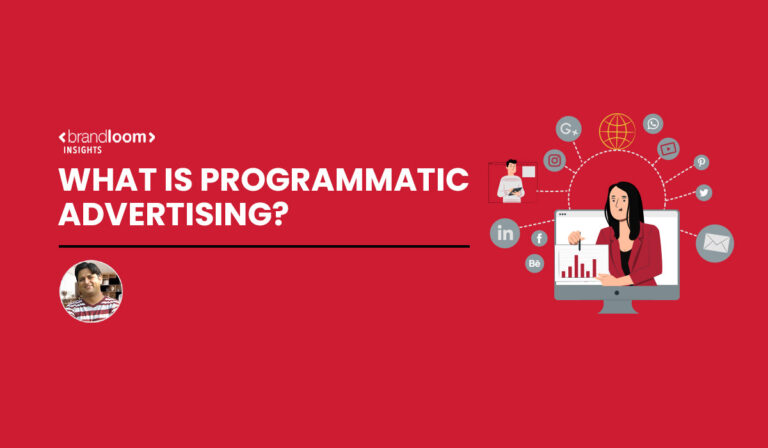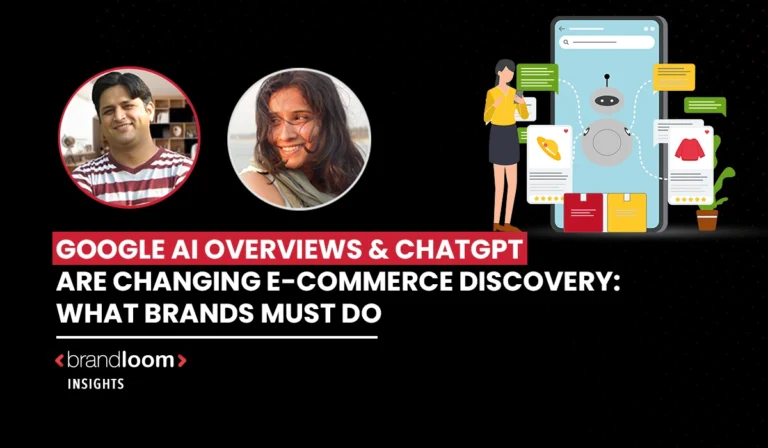Have you ever wondered how and why you start seeing ads for the products or services you have started to explore? I am not sure if you have noted that you see a lot of ads daily on the Internet through your mobile or desktop. Well, the secret is Programmatic advertising.
Yes, this is not a coincidence. These ads are carefully crafted to target those interested in that product or service. These ads are different for everyone, even though they look at the same content.
That’s what we mean by programmatic advertising.
Programmatic means how ads are purchased and placed is fully automatic and based on user behavior.
When billions of people are active on various online platforms, we don’t know where to find the right target audience. Here programmatic advertising bridges that gap.
And Brandloom is here to help you with that.
Programmatic advertising is a billion-dollar industry emerging as a dominant digital advertising model.
According to Statista (2021), The US was the market leader in programmatic ad spending. The Global programmatic advertising market size was US$ 418 billion in 2021.
Global spending by 2026 is expected to rise to US$724 billion and is expected to grow even more in the coming years.
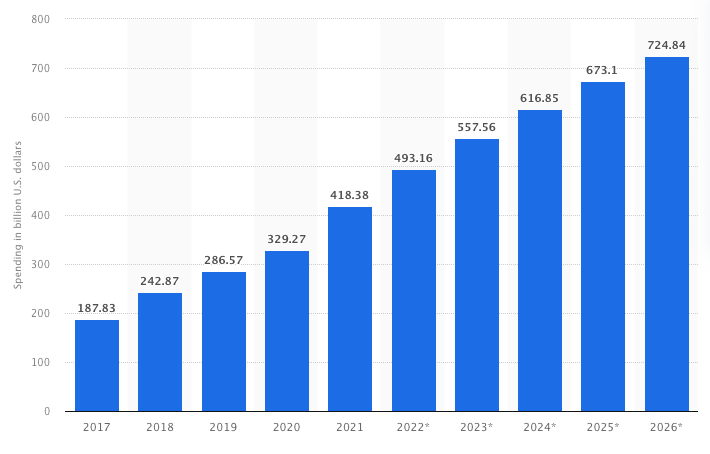
Today, marketers are investing more than 50% of their media budget in this particular form of advertising.
This unique form of advertising is taking online advertising by storm. But what makes it so special?
Let’s find out.
What is programmatic advertising?
While this term can be complex to understand for beginners, we will put this as simple as possible.
Programmatic advertising is buying and selling digital ads through automated platforms without manual interventions.
These are online ad spots where advertisers buy and place their ads using automation instead of manual methods.
The programmatic ad-buying system allows advertisers to use automation to buy ad space, choose ideal locations, target their ads, and more.
These ads can be in the form of audio, display, video, or social channels.
In older days, the ordering, reporting, and ad set needed were done manually.
Now, the process is streamlined through programmatic advertising, which is more efficient and effective.
It provides access to any channel or format as the programmatic platform has its ad inventory and database.
Here, the system automatically purchases space for advertisement on several digital platforms, be it websites, channels, or platforms.
The automated system does this in real-time and lets advertisers place ads on multiple channels without human interaction.
And then, publishers can start receiving automatic bids for their issued ad inventory via the supply side, platform, monetization partner, or ad network.
Programmatic Meaning
Programmatic means according to a program or method.
In online advertising, programmatic is the marriage of two words: program and automatic. Programmatic means using programs or software to automate the ad management, buying, and measurement process. (Source)
Programmatic advertising meaning in advertising
Programmatic advertising means using automated technology for media buying. Media Buying is an advertising space that beats the traditional (manual) digital advertising methods. It utilizes data insights and algorithms to show ads to the right user at the right time and at the right cost. To understand programmatic media buying, you should know all the necessary terms related to the process.
How did Programmatic Advertising begin?
The main goal of advertisers is to send out marketing messages that can entice their target audience into taking action, such as buying a product or a service.
To make it happen, the publishers need a website with appealing content that can attract its target audience.
However, before the programmatic technology, advertisers used to pay for banner ads, which later publishers would manually paste onto the sites.
This went on for some time, but it wasn’t effective.
There was substantial potential ad space that was unused and unmonetized.
One solution for this was ad networks. It categorized unsold ad inventory and made it easier to access and include media campaigns.
Since then, online media got separated into premium and remnant ad inventories. The premium ads were sold through the direct relationship between publishers and advertisers. Remnant ad inventories were sold through ad networks.
With time, it got complicated for publishers to manage access to their inventories, making it difficult to sell ad space. This was when DSP and SSP emerged to make the process easier. DSP helps maximize revenue and acts as a shield between you and third-party advertising.
With its help, the publisher can control the ad inventory and how it’s sold and delivered. The bidding system of SSP helps the publisher get the highest bids and generates the most possible revenue for the ad space.
Let’s take a deeper look at these important terminologies and how it works.
How does programmatic media buying works?
Till now, we know how these ads have become popular; what their importance is in the market, but let us understand how it works.
Programmatic ads connect publishers who have space on their website (ad inventory) with advertisers who want to promote their brand by running their ads in those ad spaces.
This is what it looks like-
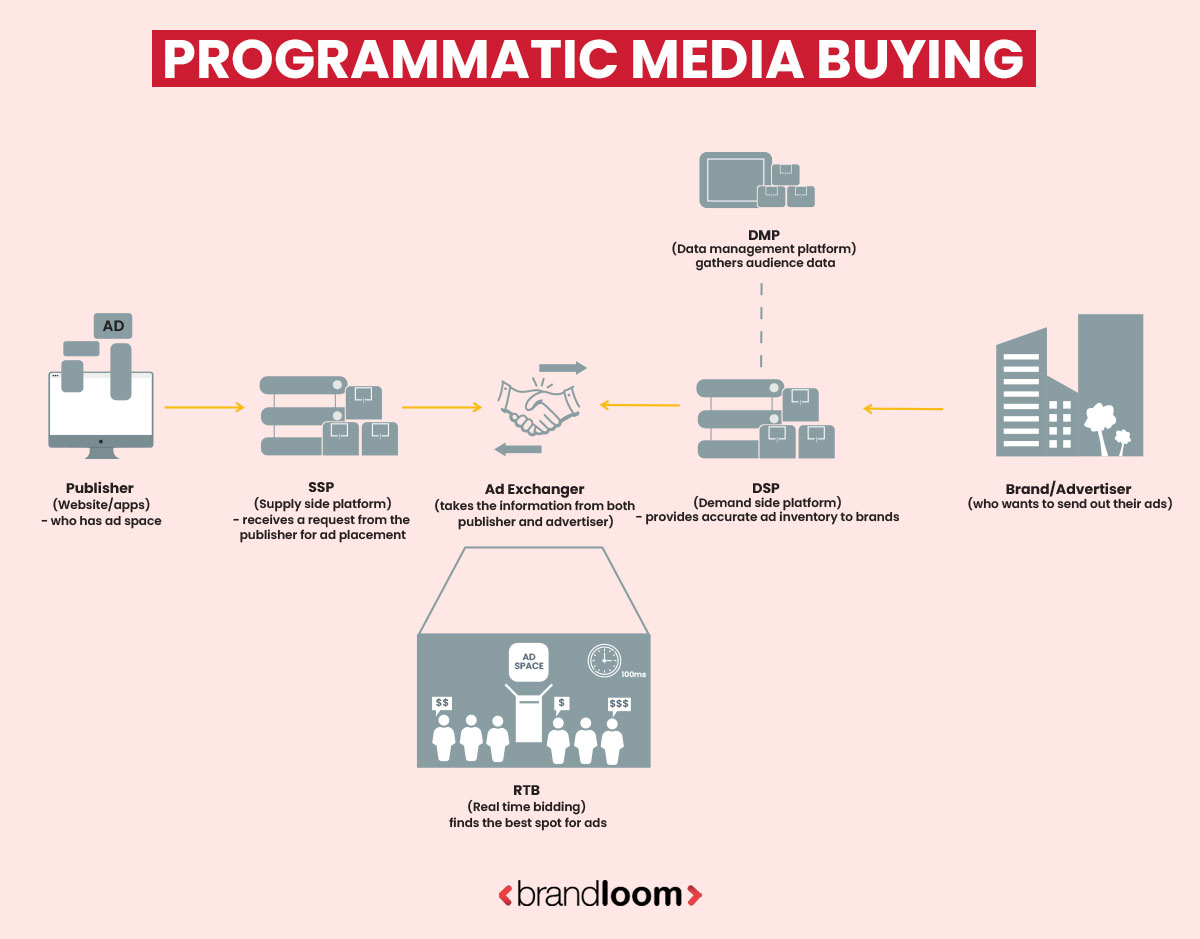
Programmatic advertising ecosystem
To be clear, at the time of a launch of a digital campaign, an advertiser might want to promote the product or service. So for that purpose, he might call the programmatic ad agency or trading desk to get started. The agency uses the Demand Side Platform (DSP) to initiate the process of purchasing ad impressions, as explained earlier in the content.
DSP lets advertisers/agencies buy ad inventory from various publishers. It ensures the ads are best suited for the right audience through a data management platform (DMP). DMP covers all the audience data that are needed to run the ads. It helps target the right audience by considering multiple factors such as demographics, location, online activity, and user behavior.
When the advertiser’s target audience lands on the publisher’s website, the site sends a request to the Supply Side Platform (SSP). The role of SSP is to run an auction among the buyers. The publisher uses SSP to sell these ads to maximize the value that the publisher gets from an impression.
Then the DSP uses this received data, evaluates the ad, and matches it with their data and target parameters. This helps decide the bidding price for the first impression. As it is apparently an ad exchange in real-time, it is also referred to as real-time bidding (RTB).
Real-Time Bidding allows quicker and more precise targeting, enabling ads to be bought or sold on a per-case basis. It means only visitors who are your target audience will see the ad.
How long does it take?
This might seem like a long process, but it takes just a hundred milliseconds to finish the bidding. Once the impression is sold, it is delivered to the publisher’s website to be displayed. The complete process repeats every time someone lands on the website or refreshes.
Let’s see in detail-
In simple words
Consider one of your target audience, say, Harry, who wants to check the results of a baseball match. So he types ‘baseball math score’ on the Google search bar and opens one of the top pages.
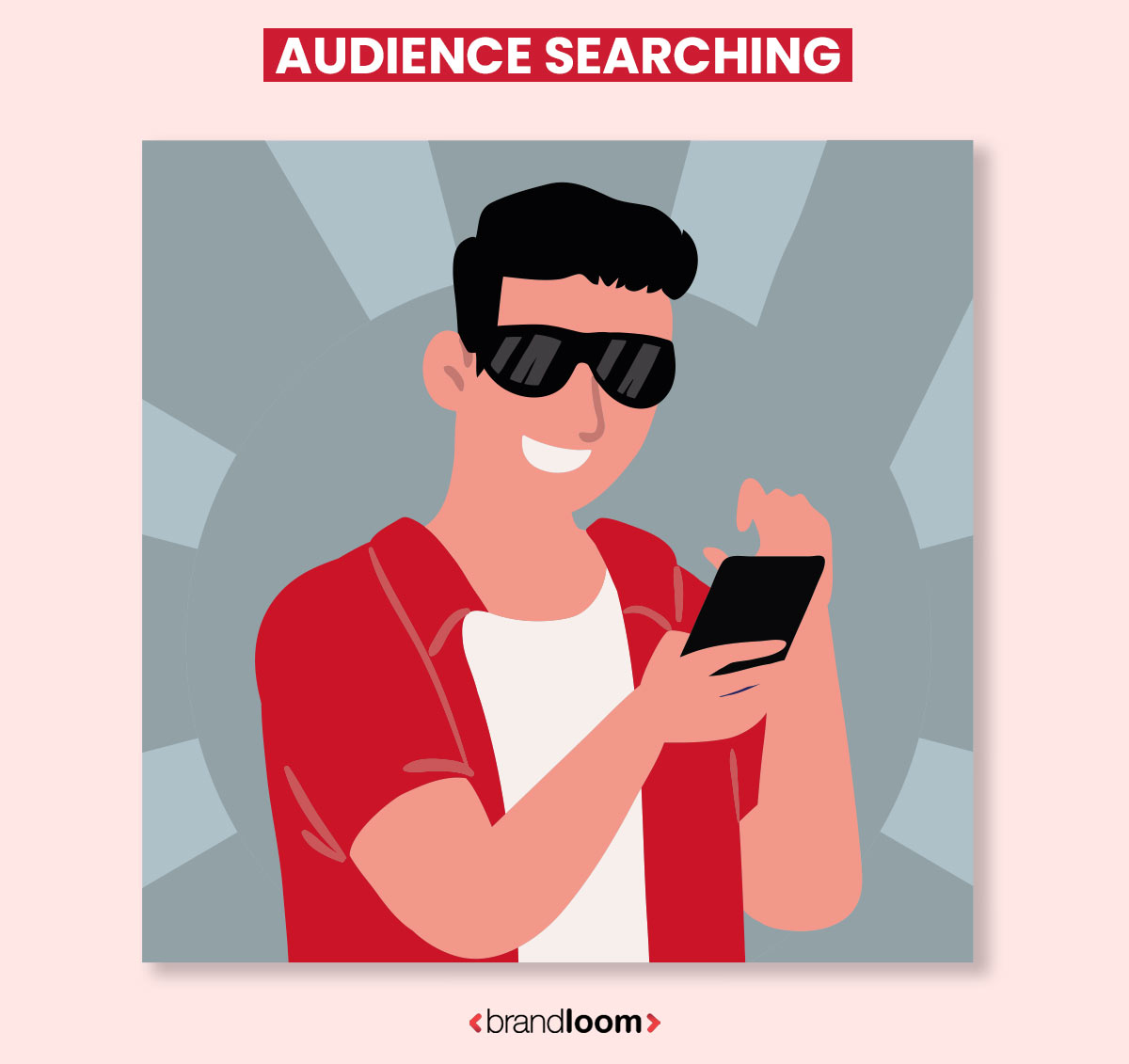
Harry doesn’t know that a lot is happening in the back while the page loads. The website he has clicked on has dedicated space to serve ads to him. This website, aka publisher, must send a request to an ad exchanger to get the best price for its space. The ad exchanger here is SSP.
The ad exchange creates an ad request with the necessary information, such as URL, device type, IP address, cookies, and category, based on Harry’s intent and location.
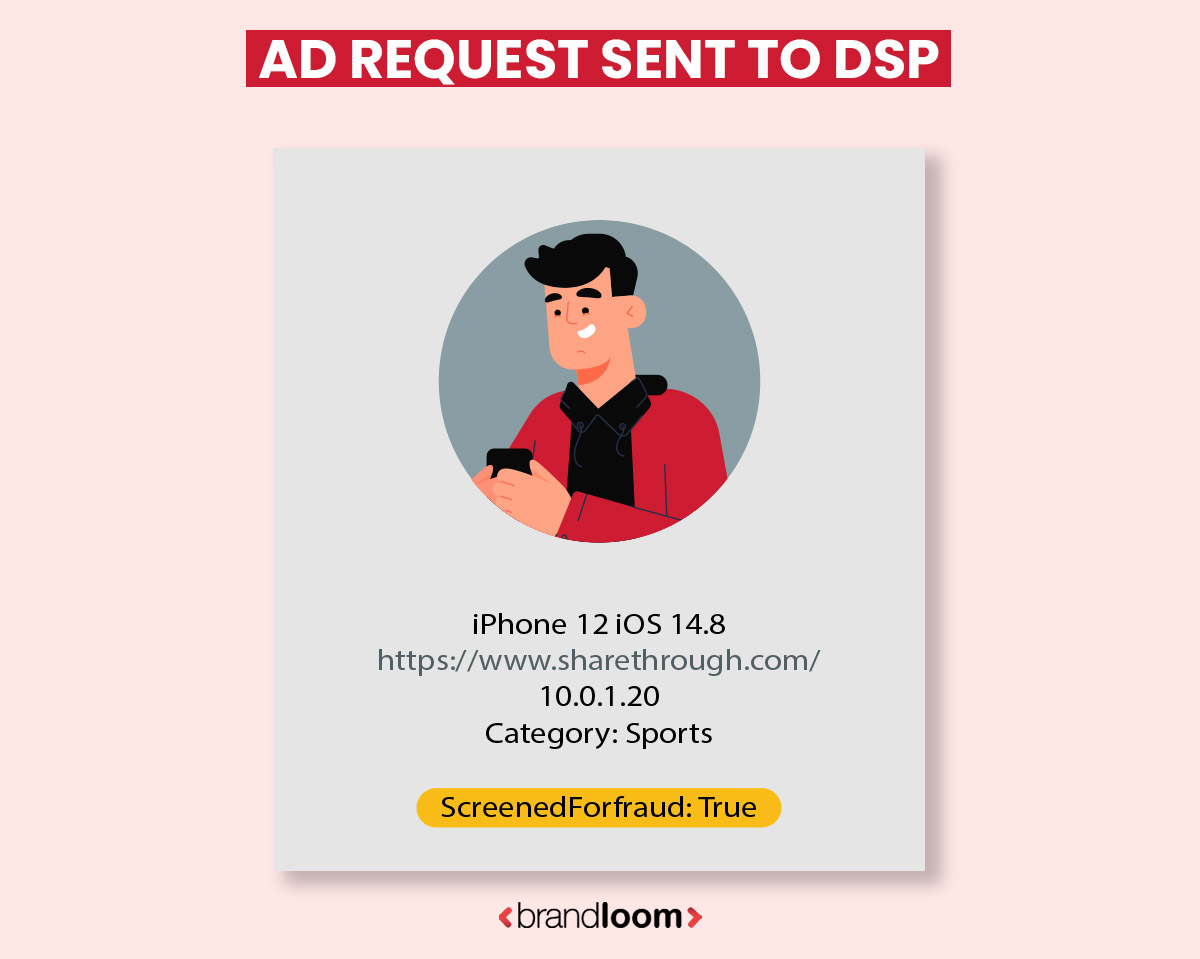
This ad request is sent to DSP, and this is where the brands show up.
DSPs constantly keep receiving ad requests from one end, while the brand on the other end has already determined the targeting, the type of campaign, and the platform’s bidding price that they are willing to pay.
DSP determines which brand would be perfect for the respective platform and submits its bids to the ad exchange.
The ad exchanger checks the bids by verifying publishers’ rules and presents the best bid.
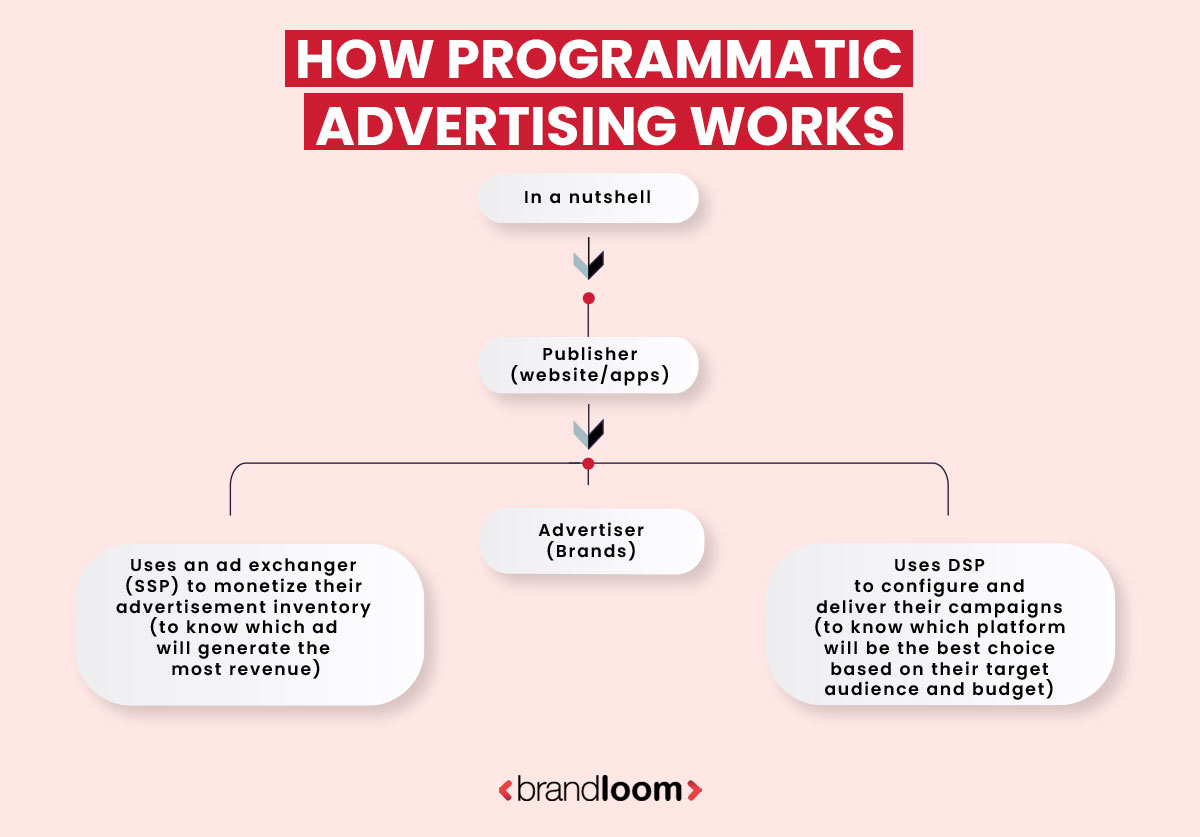
Then the winning bid goes straight to the publisher along with other bids. The publisher then makes a decision and chooses a winning bid, and shows it through its own advertising software. Finally, the ad exchange will put the ad on the page Harry had clicked on.
Now Harry can see the content of the page along with this ad, and he can engage with it if he likes it.
What programmatic advertisement did here was- examine the best spot to put an ad that benefits all- the target audience, the brand, and the ad platform.
Types of Programmatic Advertising
1 Display Ads
Display advertising are those that are positioned in a publisher site’s header, footer, and sidebar.
2 Video ads:
These advertisements play in videos either before they start (pre-roll), during them (mid-roll), or at the end of them (post-roll).
3 Social advertisements:
Using data from the platform, adverts are automatically distributed on social media.
4. Audio ads:
Promotions are included in audio files like podcasts.
5. Native ads:
These are advertisements that take on the format of the content they are displayed in, such as in Amazon-sponsored listings or content ads.
Who Uses Programmatic Advertising?
Programmatic advertisement is for any business or enterprise that wants to advertise on a digital screen. It has eliminated the need to publish and purchase ads manually, which was unreliable and expensive.
Programmatic advertising help marketers reach new heights of success as publishers are enabling native ads on their websites. This type of advertising is popular because the ad space is less affected by ad blockers compared to other ads and platforms.
Also, it gives marketers more time and opportunity to optimize and improve the ads with programmatic techniques.
What are good programmatic advertising examples?
Most programmatic advertisements are a success, but here are some examples of popular campaigns which immensely were successful. These are real-world examples showcasing how powerful this advertisement is.
1. The Economist
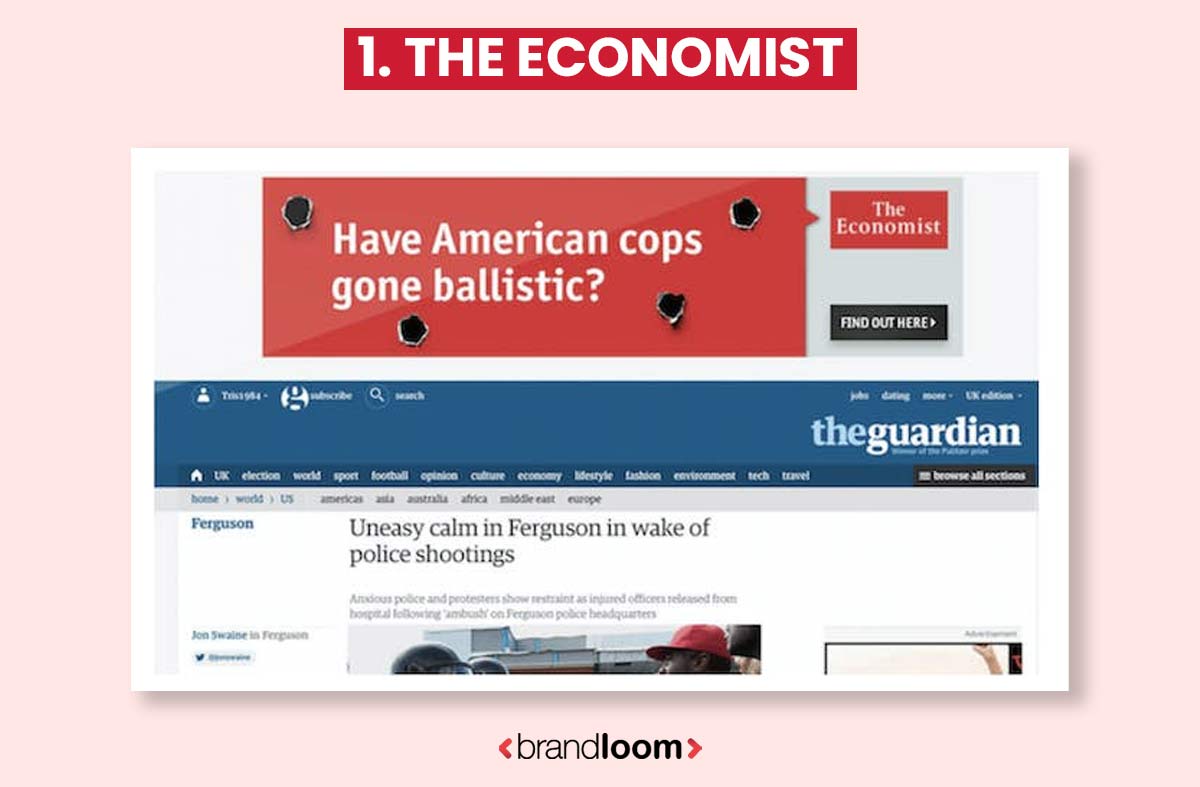
This award-winning campaign had a huge return on investment.
They leveraged publications’ content and mixed it with humorous headlines. They targeted intellectually curious readers who had not previously spent much time on the Economist website.
Finally, the results were very impressive. company said they had generated 650,000 new prospects and persuaded 3.6 million to take action with a campaign with an ROI of 10:1 for a £1.2m media budget.
There was also an increase of around 64% in brand awareness in the US, with about 22% consideration.
2. Audi
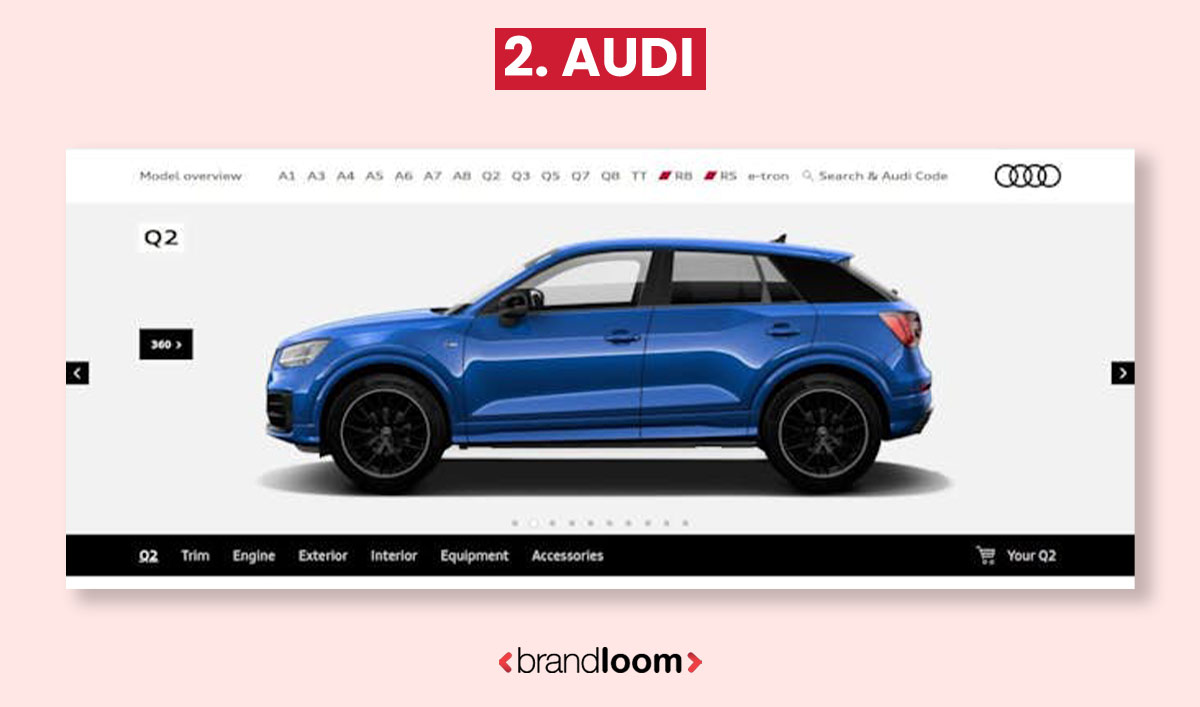
For the launch of its new customizable vehicle, the global automotive brand Audi aimed to personalize its marketing efforts. With that in mind, they crafted a campaign that resonated with its iconic slogan, ‘Vorsprung Durch Technik,’ which means- Advancement through Technology.
They worked in close collaboration with Google and used display and Video 360 tech. Audi opted for a data-driven approach combining all customer data instead of relying on siloed information.
Programmatic techniques helped marketers optimize their most valuable customer touchpoints.
Through programmatic advertising, the brand was able to capture behavioral data and improve marketing segmentation. It allowed the users to customize their dream car with 6000 possible combinations.
These combinations and artworks done by the people were then used to generate personalized dynamic ads- which multiplied the ad efficiency. The programmatic ads increased the conversion rate to four times higher than ads at the traditional level.
All these campaigns show how powerful programmatic advertising is in targeting the right customers at the right time and getting meaningful engagement with measurable conversions.
Programmatic is a simple and scalable process once you get the hang of it.
3. IHG
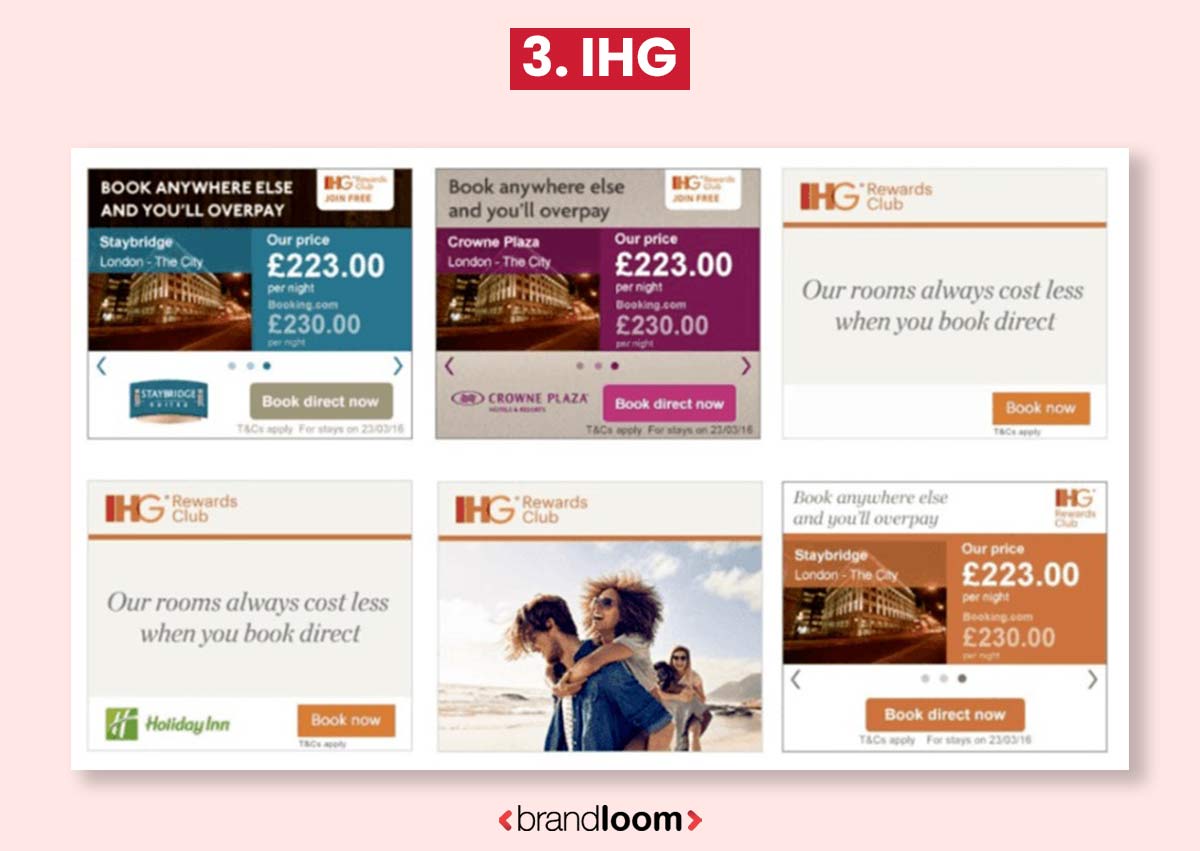
When analyzing how people book hotels, IHG figured that most people use third-party booking websites, like Hotwire, in search of the best possible price. However, IHG knew that these sites generally cost travelers 15 to 30% more than booking with a hotel directly.
This was the inspiration behind IHG to try programmatic advertising.
With programmatic ads, IHG showed users that booking directly with hotels, like Crowne Plaza or Holiday Inn, would cost lesser. IHG personalized these ads for user segments based on date, hotel location, and price based, traced from the user’s browsing history.
These ads worked very well as they provided transparency about cost. Instantly, users knew the amount it would cost to stay at that hotel for a day, and they could easily compare it with the price of a third-party booking site.
These powerful ads didn’t just try to persuade users that it was economical to book with the hotel — they actually showed that fact to users.
How and why is programmatic marketing successful?
Programmatic advertising is highly successful today because it is efficient, scalable, and targeted—with an estimation of programmatic ads reaching $724 billion in 2026.
Previously, people had to spend a lot of money to reach their target audience with the right platform. Now, with programmatic ad buying, people can rely on an algorithm that determines exactly where the ad money is best spent.
You just need to feed your programmatic solution information about your audience and campaign. Key performance indicators and the algorithm will give you the perfect answer.
The system will launch your campaign, consistently monitor your ad spending, and find areas of improvement. It is the best way to optimize ad spending, boost your ROI, and resonate with the target audience on the right platform at the right time.
Why Programmatic Buying is Important for Advertisers?
There are innumerable advantages of programmatic advertising for advertisers. First, they get access to the ad inventory, the pool of opportunities. Some of the ways it has helped the businesses of the advertisers are-
Why should you go for Programmatic advertising?
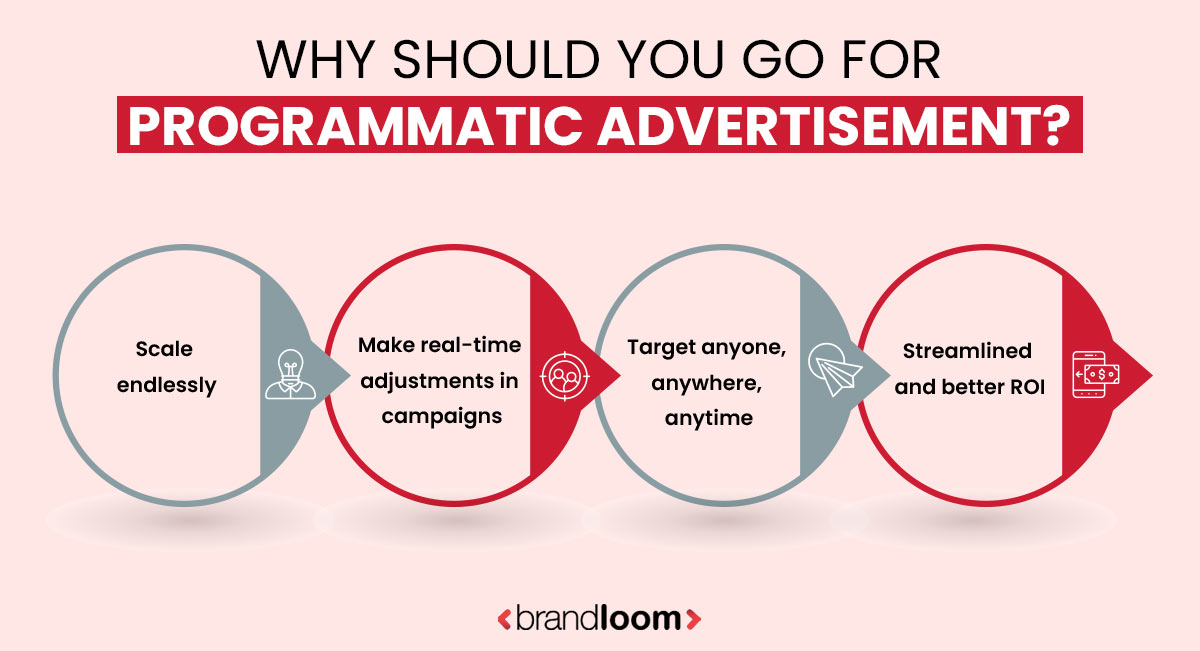
- Ability to scale– Programmatic advertising lets advertisers reach a large audience by buying ad space from the available ad inventory.
- Real-time flexibility– Advertisers get the opportunity to make real-time adjustments to ads depending on the impressions they are getting. Also, they can use a broad range of targeting criteria to target perfectly.
- Targeting capabilities– Programmatic targeting puts advertisers’ budgets to better use and ensures it
- Efficiency– The complete process is more streamlined, and it shows relevance to the target audience. With access to a large pool of publishers, advertisers can get better ROI on their investment, and publishers can maximize their revenue at the same time.
Programmatic Advertising Platforms
A programmatic advertising platform lets marketers and advertisers automate the purchase and management of their ad campaigns.
Many programmatic platforms, such as SmartyAds, allow programmatic advertising. These platforms are available for publishers to help them find the right services and ones that meet their needs.
Each element of the programmatic advertising system works to serve benefit both advertisers and publishers. Some popular platforms are demand-side platforms, supply-side platforms, ad exchange, and data management platforms.
Best Programmatic Advertising Platforms
Here are some of the best programmatic advertising platforms:
- Pubmatic
- IgnitionOne
- Sizmek
- Adobe Marketing Cloud
- Tubemogul
- Google Marketing Platform
- Amobee
- Digilant
- Disruptive Advertising
- Fyber
- SmartyAds
- Choozle
- Appnexus Console
- AdRollKedet
- MediaMath
What’s next for programmatic advertising?
Emerging technology, such as artificial intelligence and machine learning, is impacting everything, and programmatic marketing is no exception. Programmatic advertising is influenced by trends, changing attitudes, and customer behavior, adding several other factors which cannot be analyzed better with the help of advanced technology.
1. Artificial intelligence
ML and AI find patterns and predict real-time results with multiple data points. With the fast development of artificial intelligence, it can combine the mapping of the matrix with user data so we can place it more accurately in a cost-effective manner.
2. Increased personalization
Programmatic technology is extremely helpful in optimizing ads and measuring the data in real time. It has the power of artificial intelligence to provide necessary insights and deliver precise messaging to the right users.
Dynamic creative optimization lets advertisers offer relevant and personalized at two target people, which is a plus point for publishers. It understands who the user is and fixes the best creative combination to spread the right message to every user. It makes you are that everyone sees the relevant ads only.
3. Preventing Ad Fraud
Digital ad fraud is a persistent problem in the marketing industry. In 2021 advertisers lost about $65 billion globally to ad fraud. Programmatic advertising is extremely helpful as it also helps prevent fraud. Advanced technology, such as blockchain, and an initiative called ads.txt, are very helpful for the same.
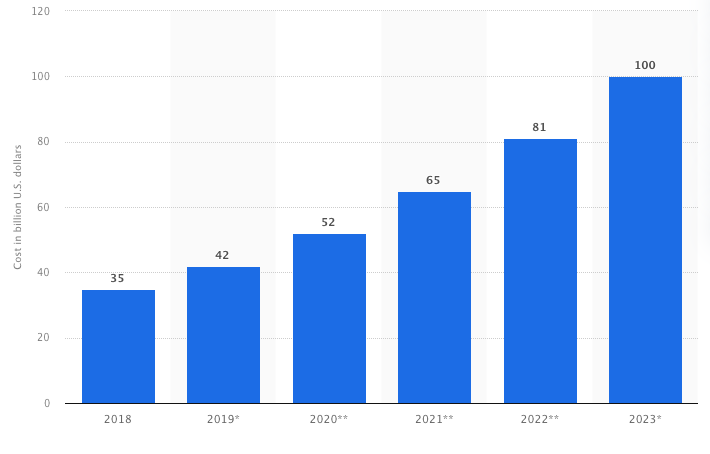
Publishers can simply add the ads.txt file with the list of inventory sellers to their web server, and programmatic platforms do the same to guarantee buyers pay for valid ad space. This helps minimize any fraudulent activities that can take place in advertisements.
Also, an industry-leading extension for ad ops called AdWizard lets publishers manage the ads appearing on their site and protect the brand.
Conclusion
The future is shining bright for programmatic advertising, and now is an excellent time to get in on this trend.
Accessibility has never been better for smaller brands, and hopefully, this article helped you get a better view of what it’s about.
If you’re excited to try programmatic ads and want to explore what they can do for your campaigns, Brandloom is an excellent place to start!
We offer consultation and a bundle of digital marketing services that can be the loophole you never knew existed.
Reach out to us, and let’s talk about growing your business.
Frequently Asked Questions
Even though it’s an automated process, you need to know certain details before putting up your first programmatic advertising for your business.
Know your marketplace
Do some research and figure out what is workable for you. Figure out business goals, based on the competitors. As you venture into a new area of advertising, you might come across many new ideas. Keep them all on a list and explore them when the right opportunity arises depending on your marketplace.
Also, if you are new to programmatic advertising, check out all the terms. This is so you can better understand and differentiate between SSP and DSP.
Set your programmatic advertising goals
Have a determined goal in your mind about the objective behind the campaign. Figure out the type of advertising awareness you need, and build an effective strategy accordingly. That helps you determine short and long-term goals.
The benefits of programmatic advertising are probably more than what we have written here. It offers a faster, smarter alternative to manual digital advertising. Before it came along, all the ads were reported and set up manually, which took a lot of time.
Both the advertisers and publishers found themselves struggling with managing space and manually negotiating the purchase of ads was also time-consuming.
Programmatic advertising has brought solutions to all these problems, and hence it has promising growth in the future.
A programmatic advertising platform lets marketers and advertisers automate the purchase and management of their ad campaigns.
Many programmatic platforms, such as SmartyAds, allow programmatic advertising. These platforms are available for publishers to help them find the right services and ones that meet their needs.
Each element of the programmatic advertising system works to serve benefit both advertisers and publishers. Some popular platforms are demand-side platforms, supply-side platforms, ad exchange, and data management platforms.
Programmatic advertising usually works on a CPM (Cost Per Impression) model, which is the cost of 1000 ad impressions on a website.
The cost for more specific targeting for both publishers and advertisers will be higher.
These are the factors to consider while calculating the cost-
Targeted device
Type of industry
Ad format
Ad placement on the page
Programmatic CPMs are usually cheaper than social media advertising techniques and offer significantly better value than traditional offline approaches.
Programmatic ads CPM is usually between US$0.50 and US$2, cheaper than social media platforms (where CPM can go as high as an average of US$6-US$7).
Small businesses with limited marketing budgets can implement programmatic ads as a digital marketing strategy.
Programmatic advertising means using automated technology for media buying. Media Buying is an advertising space that beats the traditional (manual) digital advertising methods.
It utilizes data insights and algorithms to show ads to the right user at the right time and at the right cost.
To understand programmatic media buying, you should know all the necessary terms related to the process.
Programmatic media buying has three different types:
– Real-time bidding (RTB): Open auction or RTB is when the system decides the inventory cost through the auction in real-time. This is open to any advertiser/publisher.
– Private Marketplace (PMP): This is similar to open auctions; however, PMPs have limitations on who can participate. Only some advertisers have access to PMPs on an invitation basis. But, in some cases, publishers can have a selection process that lets advertisers apply for an invitation.
– Programmatic Direct: This means a publisher can bypass auctions and sell media inventory at a fixed cost each mile (CPM) to one or multiple advertisers.
Real-time bidding is a form of programmatic buying.
Real-time bidding (RTB) is an automated method that allows advertisers to make real-time bids for particular display ad locations.
Though RTB is a programmatic process, not all programmatic advertising uses RTB technology.
Although RTB is one of the most popular ways to buy advertising since it gives advertisers cost control while giving them access to various advertising platforms across different channels, it’s vital to realize that RTB is not the only option to buy programmatic advertising.
For marketers, who are looking to grow their brands and sales, Programmatic Advertising could be challenging. If you want to draw maximum results, get in touch with programmatic advertising agency like BrandLoom, who will take care of all the efforts.
Yes, Facebook is a form of Programmatic Advertising.
Yes, Facebook Ads Manager can be described as a DSP. However, it is not an efficient DSP as it draws primarily from its own inventory. A true DSP may have thousands of websites to provide maximum bang for the buck to advertisers.
Many people confuse these two media buying methods as both terms carry “guaranteed” terms.
It is worthwhile to know that both methods are executed programmatically, yet they differ in execution and the processes to seal the deal.
With Automated Guaranteed, publishers decide what “packages” of their inventory to expose to the buyers and then negotiate on the price. At the same time, with Programmatic Guaranteed, advertisers get access to the full information about the inventory and the website’s audience and then decide what to make an offer for.
Programmatic advertising is a billion-dollar industry emerging as a dominant digital advertising model.
According to Statista (2021), The US was the market leader in programmatic ad spending. The Global programmatic advertising market size was US$ 418 billion in 2021.
Global spending by 2026 is expected to rise to US$724 billion and is expected to grow even more in the coming years.
Today, marketers are investing more than 50% of their media budget in this particular form of advertising.
This unique form of advertising is taking online advertising by storm. But what makes it so special?

